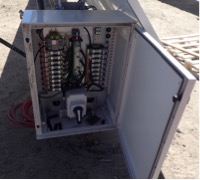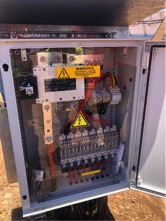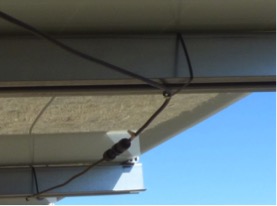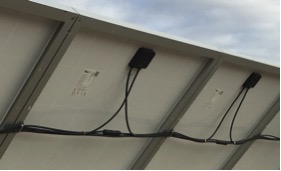Electrical safety on solar farms
- This esafe bulletin was correct at the date of publication. Since then, the code was remade on 5 April 2024 as the Construction and operation of solar farms code of practice 2024 (PDF, 1.07 MB) following a limited internal review which did not change any requirements for industry.
- The code includes information on how workers, designers, constructors and operators of solar farms can comply with their existing safety responsibilities.
The Electrical Safety Office (ESO) and Workplace Health and Safety (WHS) have been auditing and investigating incidents on Queensland solar farms. 30 solar farms have been visited over the last 12 months with 67 notices issued. ESO Inspectors have issued improvement and infringement notices for unsafe isolation and securing and protection of cables, unlicensed work, earthing, marking and labelling, and testing. Electrical workers and electrical contractors have also been referred to the Electrical Licensing Committee for consideration of disciplinary action. Electrical safety issues identified so far include:
Inadequate isolation of energised PV cables and associated equipment
Electrical and non-electrical workers have received electric shocks and arc flash injuries while working on or near energised DC string cabling and DC busbars. All cables and connections should be isolated before work is commenced on cables or connections, or near where they may be disturbed.
There have been several incidents working on, in or near combiner boxes and connections at combiner boxes. In one, a worker sustained burns from an electric arc while changing connectors in a solar panel combiner box at a solar farm. In another, a worker received an electric shock and burns to his thumb and fingers. He was attempting to identify a route for a SCADA extra low voltage cabling through a power conditioning unit bus bar section. He placed his hand inside the cabinet inadvertently contacting a 1300 volt DC bus bar.
 Combiner box 1 |  Combiner box 2 |
Combiner box 1 has a poor design where opening the enclosure to operate the isolator switch exposes all live terminals. Combiner box 2 has a better design with an intermediate barrier over live parts and the isolator switch is operated with the enclosure closed.
Inadequate securing and protection of DC cable strings and looms
Inspectors have found plastic cable ties being used to support DC cables. Plastic cable ties must not be used as the primary means of support. Plastic cable ties installed under an array are still exposed to reflective UV radiation.
Other non-compliant issues include inappropriate cable clips not adequately supporting cables where panels rotate, non-UV rated conduits installed for mechanical protection of cables, and DC cables being subject to mechanical damage from sharp edges.
 Example of poorly supported PV cables using plastic cable ties |  Example of better supported PV cables using metal ties |
Unlicensed people carrying out electrical work
Inspectors have found unlicensed people carrying out cable installation (including 1500V rated DC mains underground cable and PV solar string cables), making connections for the earthing system, and making the plug-in connections of the interconnecting wiring between PV panels.
Earthing of PV panels and associated equipment
There have been non-compliances related to testing and commissioning of installations. This includes electrical contractors not testing earthing continuity between all PV module frames to the earth system of the support structures.
Inadequate marking of HV and LV electrical equipment
Marking and labelling of all equipment, control and protection devices, and isolation devices and their relationship to each other has not always been clear enough to enable persons to make informed decisions during switching or isolation activities.
Testing of electrical connections
A combiner box caught fire when the PV string fuses were being inserted. It was identified that a PV string was connected with incorrect polarity. The string conductors were incorrectly identified and the testing conducted was inadequate.
Principal contractors, electrical contractors and workers at solar farms are reminded that:
- a business or undertaking that contracts to perform electrical work must have a current Queensland electrical contractor licence. This includes sub-contracting electrical work
- only licensed electrical workers can perform electrical work
- risk assessments, safe work method statements (SWMS), and isolation procedures must be undertaken before any work is performed. The hierarchy of control must be applied as part of the risk management process.
Principal contractors and electrical contractors at solar farms must ensure all electrical risks associated with constructing, operating and maintaining DC solar systems are properly managed. They have a duty to ensure the work is conducted in a way that is electrically safe and should take note of the incidents highlighting the electrical risks working in and around combiner boxes.
Further information
Installation requirements can be found in AS/NZS 3000 wiring rules and, in the absence of other Australian installation standards or codes, you can obtain guidance from AS/NZS 5033 Installation and safety requirements for photovoltaic (PV) arrays.
The ESO and WHS has developed the Construction and operation of solar farms code of practice 2024 (PDF, 1.07 MB) to give further guidance for safety at solar farms.